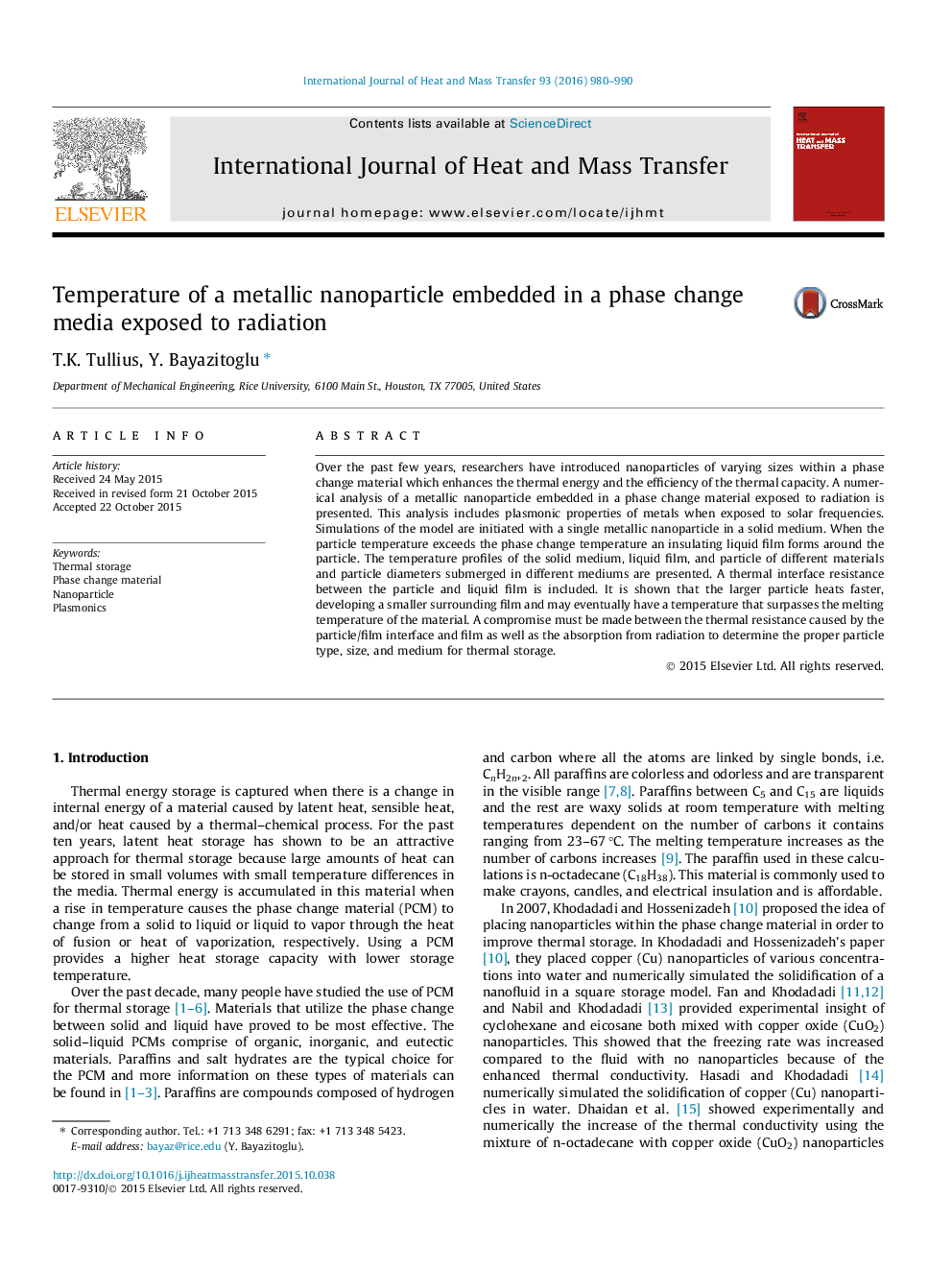| کد مقاله | کد نشریه | سال انتشار | مقاله انگلیسی | نسخه تمام متن |
|---|---|---|---|---|
| 7056296 | 1458049 | 2016 | 11 صفحه PDF | دانلود رایگان |
عنوان انگلیسی مقاله ISI
Temperature of a metallic nanoparticle embedded in a phase change media exposed to radiation
ترجمه فارسی عنوان
دمای یک نانو ذرات فلزی که در رسانه تغییر فاز در معرض تابش قرار دارد
دانلود مقاله + سفارش ترجمه
دانلود مقاله ISI انگلیسی
رایگان برای ایرانیان
کلمات کلیدی
ذخیره سازی حرارتی، مواد تغییر فاز نانوذرات، پلاسمونیک،
ترجمه چکیده
در طول چند سال گذشته، محققان نانو ذرات مختلفی را در یک ماده تغییر فاز معرفی کرده اند که انرژی حرارتی و کارایی ظرفیت حرارتی را افزایش می دهد. تجزیه و تحلیل عددی یک نانوذره فلزی که در یک ماده تغییر فاز در معرض تابش قرار گرفته است. این تجزیه و تحلیل شامل خواص پلاسمونی فلزات در معرض فرکانس خورشید است. شبیه سازی مدل ها با یک نانو ذرات تک فلز در یک محیط جامد آغاز می شود. هنگامی که دمای ذرات بیش از دمای تغییر فاز است، یک فیلم مایع عایق تشکیل شده در اطراف ذرات تشکیل شده است. پروفیل های دما از محیط جامد، فیلم مایع و ذرات مواد مختلف و قطر ذرات در مواد مختلف در زیر آب قرار می گیرد. مقاومت رابط حرارتی بین ذره و فیلم مایع گنجانده شده است. نشان داده شده است که ذرات بزرگتر سریعتر حرارت می یابند و یک فیلم اطراف کوچکتر تولید می کنند و در نهایت می توانند دمایی بالاتر از دمای ذوب مواد داشته باشند. سازگاری بین مقاومت حرارتی ناشی از رابط ذره / فیلم و فیلم و همچنین جذب از تابش برای تعیین نوع ذره، اندازه و محتوا مناسب برای ذخیره حرارتی باید ساخته شود.
موضوعات مرتبط
مهندسی و علوم پایه
مهندسی شیمی
جریان سیال و فرایندهای انتقال
چکیده انگلیسی
Over the past few years, researchers have introduced nanoparticles of varying sizes within a phase change material which enhances the thermal energy and the efficiency of the thermal capacity. A numerical analysis of a metallic nanoparticle embedded in a phase change material exposed to radiation is presented. This analysis includes plasmonic properties of metals when exposed to solar frequencies. Simulations of the model are initiated with a single metallic nanoparticle in a solid medium. When the particle temperature exceeds the phase change temperature an insulating liquid film forms around the particle. The temperature profiles of the solid medium, liquid film, and particle of different materials and particle diameters submerged in different mediums are presented. A thermal interface resistance between the particle and liquid film is included. It is shown that the larger particle heats faster, developing a smaller surrounding film and may eventually have a temperature that surpasses the melting temperature of the material. A compromise must be made between the thermal resistance caused by the particle/film interface and film as well as the absorption from radiation to determine the proper particle type, size, and medium for thermal storage.
ناشر
Database: Elsevier - ScienceDirect (ساینس دایرکت)
Journal: International Journal of Heat and Mass Transfer - Volume 93, February 2016, Pages 980-990
Journal: International Journal of Heat and Mass Transfer - Volume 93, February 2016, Pages 980-990
نویسندگان
T.K. Tullius, Y. Bayazitoglu,
